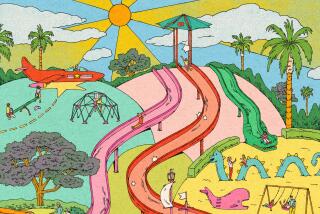Survey Cites Playground Hazards
- Share via
IRVINE — Some Orange County playgrounds pose hidden threats to youngsters, including inadequate protective surfaces, slides that are too high or equipment that could cause strangulation, according to a national consumer survey released Thursday.
“Public playgrounds can and should be places where children can grow and enjoy themselves, not . . . hazardous locations,” said Melanie Okamoto, a consumer advocate with California Public Interest Research Group, which conducted the survey along with the Consumer Federation of America. “We’re encouraging parents to get involved and schools to take action.”
In Orange County, six of seven randomly selected playgrounds lacked adequate protective surfaces; five of seven playgrounds had slides that were too high; and four of seven had equipment that could trap children’s heads. None of the playgrounds scored perfectly on the survey.
The Orange County playgrounds assessed were Edison and Eador parks in Huntington Beach; Flower Street and Logan parks in Santa Ana, and Orchard, William R. Mason and Northwood Community parks in Irvine.
Nationwide, advocates from the consumer groups surveyed 562 playgrounds in 25 states and Washington, D.C., including 58 in California.
The Orange County findings fell in line with national figures, which showed that playgrounds generally are getting safer but still pose some dangers. About 85% of the surveyed playgrounds lacked adequate protective surfaces, 61% of climbers and 45% of slides were too high and 46% of the playgrounds had head entrapment hazards that could lead to strangulation.
“Parents just don’t think about these things,” Okamoto said.
At a news conference at Northwood Community Park, Okamoto brought a ruler to point out the hidden hazards.
The area surrounding the park’s swing set was covered with sand, which was about three inches deep. Okamoto said the sand should be at least nine inches deep, according to Consumer Federation of America standards.
The swings were spaced about 20 inches apart, which is four inches less than the group’s recommended distance between swings. The park’s wooden climbing equipment included spaces that could trap children’s heads, Okamoto said.
Patricia Fierro, Irvine’s community services manager, said many of the city’s parks, including Northwood Community, were built in the 1970s or early 1980s, before playground safety standards were in place.
“We’ve been making modifications to make our playground equipment as safe as we can and to try to meet standards,” she said. “We will continue to do that.”
Despite the warnings, parents who brought their children to the Irvine park on Thursday said they believe it is safe.
Debbie Cottam, an Irvine resident with three children, said her 3-year-old daughter once had to be pried loose from playground equipment at a local park after her head became wedged between metal bars.
Even so, Cottam is not worried.
“My daughter was a little scared, but she wasn’t hurt and she knows not to do that ever again,” she said. “I’m not concerned because none of my kids have ever gotten hurt on a playground. I feel very comfortable bringing my kids here.”
This was the third nationwide study on playground safety that the two consumer advocacy groups have conducted. The organizations are also pressuring state health officials to complete regulations for playground equipment--rules that were ordered by a 1991 state law but have never been put into effect.
Nearly 150,000 children nationwide require hospital emergency treatment every year for injuries sustained on public playground equipment, the groups reported. An average of 15 children die in playground-related incidents each year. Orange County figures were not available.
Despite the reported dangers, there was some good news. The percentage of playgrounds with hard surfaces has declined from 31% in 1992 to 9% this year, the report showed. Swing seats also have gotten safer, with only 10% made of hazardous wood, metal or other rigid material, down from 26% in 1994.
More to Read
Sign up for Essential California
The most important California stories and recommendations in your inbox every morning.
You may occasionally receive promotional content from the Los Angeles Times.













